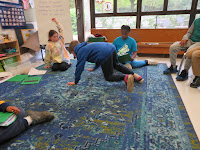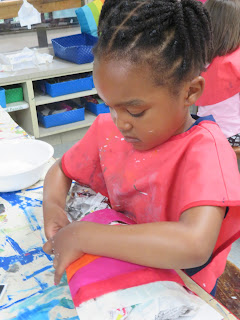In connection with third grade’s Ancient China Study, in
Spanish class the students have been learning the vocabulary for the animals
and their presumed attributes that are represented in the Chinese Zodiac. El Horóscopo Chino consists of twelve signs and is determined by the Chinese
Lunar Year. There are twelve animals, one for each year of the lunar cycle.
1. la
rata: the rat
ambicioso, trabajador y creativo
ambitious,
hard working and creative
2. el
buey: the ox
responsable, paciente y leal
responsible,
patient and loyal
3. el
tigre: the tiger
valiente, simpático y sospechoso
brave,
nice and suspicious
4. el
conejo: the rabbit
compasivo, creativo y amigable
compassionate,
creative and friendly
5. el
dragón: the dragon
brillante, honesto y entusiasmado
brilliant,
honest and enthusiastic
6. la
serpiente: the snake
sabio, callado y respetado
wise,
quiet and respected
7. el
caballo: the horse
alegre, hablador e independiente
cheerful,
talkative and independent
8. la
cabra: the sheep
amable, creativo y apasionado
loving,
creative and passionate
9. el
mono: the monkey
inteligente, chistoso y genial
intelligent,
humorous and genius
10.
el gallo: the rooster
agresivo, ambicioso y orgulloso
aggressive,
ambitious and proud
11.
el perro: the dog
honesto, leal y sincero
honest,
loyal and sincere
12.
el cerdo: the pig
cariñoso, simpático y trabajador
affectionate,
kind and hard working
The third graders have had much fun putting their new knowledge to practice. Many entertaining and
engaging games have been provided for the students to practice their listening
and reading comprehension. For example, el
juego de los matamoscas (the Swatter Game) was first played using the photo
of the animals, then with their printed name, and then with the written
personality traits that the students needed to read in order to swat the
correct one called out.
In addition, the students played a couple of rounds of
their favorite, Pulgar Arriba
(Thumbs-Up) by using flashcards with the animal photo and then with the written
word.
Charadas (Charades) was also
another entertaining game played to enhance learning...
...and crossword puzzles.
Lastly, the students
played a few rounds of another favorite, Bingo,
created just for this study. The three
characteristic traits of an animal were called out and reference sheets were
used so that the students could read and connect them with its corresponding
animal logo on their board. In later games, the students were encouraged to
play solely from memory. What a fun challenge!!
The culminating activity for the study was inviting the third graders to invent their own zodiac sign. The question was posed, “ If you could create your own signo de horóscopo, what would it look like and what would it be called?” Using Model Magic, the students crafted their ideas…


















































